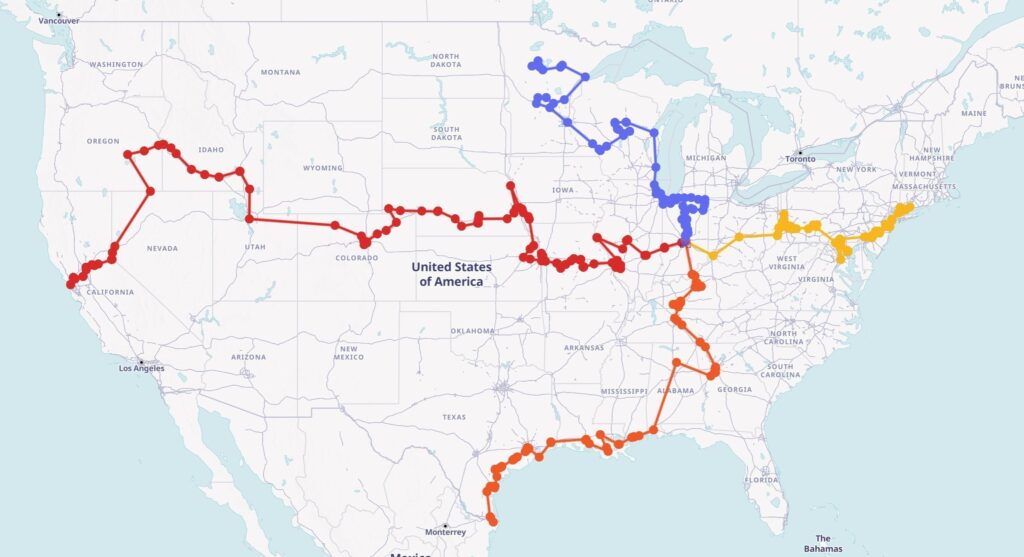
(OSV News) — There are hundreds of opportunities for Catholics to join the National Eucharistic Pilgrimage for Mass, adoration, processions, and other events. However, casually meeting up with perpetual pilgrims along the four routes may be trickier, and is even prohibited along certain sections of the journey, according to pilgrimage leaders.
“One of the challenges that we encountered as we were planning this thing out is that there are just some areas that we can’t have the public with us, because we’re either going to drive it because of time or the impossibility,” said Joel Stepanek, vice president of programming and administration for the National Eucharistic Congress, Inc. “Some areas are a little bit narrower, and we wouldn’t feel comfortable having folks join us on some of those stretches” due to safety concerns posed by a larger group.
The National Eucharistic Pilgrimage is part of the National Eucharistic Revival, a three-year initiative of the U.S. bishops to increase love for and understanding of Jesus Christ’s real presence in the Eucharist. The National Eucharistic Pilgrimage is a major component of the revival, with pilgrimage routes launching from four points in the U.S. May 18-19 and converging eight weeks later in Indianapolis for the National Eucharistic Congress July 17-21.
The routes begin in New Haven, Connecticut; Brownsville, Texas; San Francisco, California; and Northern Minnesota. Each route will be traveled by six perpetual pilgrims who are young adults selected by congress leaders; priest chaplains; and seminarians. They will be accompanying the Eucharist, often held in a monstrance specially designed for the pilgrimage.
After the pilgrimage was announced in November 2022, Catholics expressed hopes of joining the pilgrims for long stretches of walking. One priest envisioned climbing with the Western Route’s pilgrims in the Rocky Mountains; other Catholics brainstormed strategies for walking and camping along the routes for days at a time through the Midwest. From the outset, pilgrimage leaders emphasized that “day pilgrims” joining the pilgrimage for any stretch were responsible for their own food, water and overnight accommodations.
As the pilgrimage developed, however, the logistical need for pilgrims to drive between certain sites or limit the number of people walking in certain areas became more pronounced, Stepanek said. In most cases, it was not feasible for people to join the perpetual pilgrims for multiple days or weeks.
“Any time that there’s something that’s never been done before, it evolves as we move through the planning and logistics and what is possible,” Stepanek told OSV News. “Since its inception two years ago, there have been a lot of different little tweaks and evolutions to it that have made it more accessible while still maintaining the idea of ‘come join along the pilgrimage.'”
As the perpetual pilgrims wind their way toward Indianapolis, they plan to stop for prayer and other events at both Catholic and secular sites. In New York City, the pilgrims are stopping at the St. Frances Cabrini Shrine. Some stops are less than an hour, while others may stretch to a day or more. Events for each route, along with an interactive map, are at eucharisticpilgrimage.org.
“One of the really unique things that has evolved with dioceses and parishes is that there are so many public events that are happening along the route,” Stepanek said. “Whereas I think initially it was like, yeah, people will be walking and ‘join with us, walk along this route,’ has evolved to ‘hey, we’re going to be at this parish.’ … There’s a real grassroots feel to this.”
Those developments, he said, “fulfill the need for those public events that anybody can join in on,” including elders, families with young children, or people with mobility challenges.
However, “there are still plenty of places along each of the routes where people can publicly walk and come alongside the pilgrims for a several mile stretch in different areas. That still exists,” Stepanek said.
The pilgrimage’s website requests registration for each event along the route, and that registration is key for people seeking to walk with the pilgrims during or outside of scheduled events, he said.
Because routes may change due to weather or safety, the pilgrimage’s website does not include what roads the pilgrims plan to take between events, he said.
“When people sign up for an event and register, we have an email series that gives them information on where the pilgrimage is coming to their area. That information will be a little bit more clear about the particular routes that people are taking, and where people will be able to walk through that day,” Stepanek said.
Notably, one group is planning to travel the pilgrimage’s eastern route from New Haven to Indianapolis alongside the perpetual pilgrims. With the help of Father Roger Landry, the priest chaplain of the pilgrimage’s St. Elizabeth Ann Seton Route, four religious sisters from the Daughters of Mary, Mother of Healing Love have secured a truck, driver and camping trailer to make it happen.
“They’re not part of the official pilgrimage group. That’s just one of those groups that said, ‘Hey, we’re coming along with you.’ They’ve done all of their own logistical planning for that,” Stepanek said.
At least one seminarian plans to join each route as well, he said.
While all four routes include moments organizers expect to be visually stunning, such as the pilgrims crossing over San Francisco’s Golden Gate Bridge or accompanying bishops to bless the Mississippi headwaters in Northern Minnesota — both of which occur May 19 — Stepanek expects the pilgrimage’s greatest moments to be the small and even hidden encounters between people and the Eucharist.
“A lot of what I’m looking forward to are the ‘in between moments,'” he said. “I think the most powerful things are going to happen where we just don’t expect them to, and I’m excited for the chance encounters and going through the smaller rural towns. … I just think the Lord is going to show up in a big way in all of those places.”
– – –
Maria Wiering is senior writer for OSV News.


